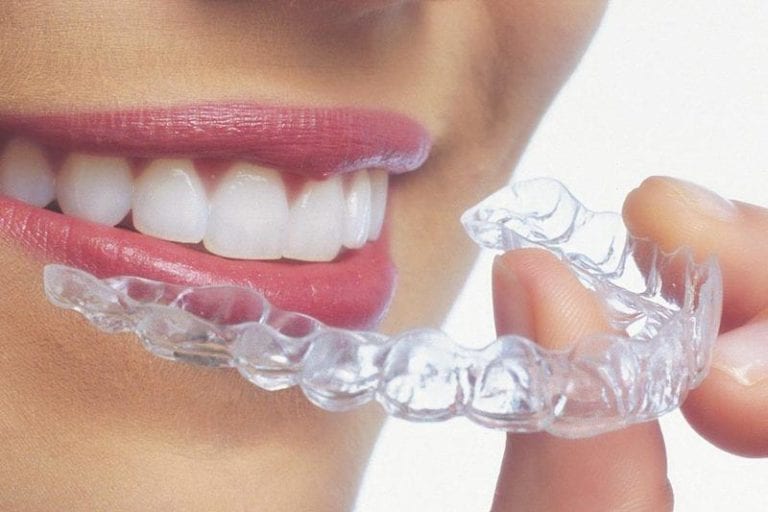How Invisalign® Works

As Invisalign® continues to grow in popularity as an effective alternative to braces, you may be hearing more about it, and find yourself wondering how the whole process actually works. Because the clear aligners don’t bear any resemblance to traditional metal braces with wires and brackets, they can be a bit of a mystery even to patients who are familiar with orthodontic treatments. So what exactly is Invisalign®, and how does it work?
Our friendly team at Dr. Robert J Herman Orthodontics has put developed this easy guide to help you understand the ins and outs of the Invisalign® system.
Invisalign 101
We already know that a big smile and straight teeth can positively affect an individual’s confidence and well-being. In fact, around 60% of people are reported to feel that straight teeth make them more confident and happy. So when a treatment called Invisalign® can correct any teeth misalignments to deliver that great smile, why wouldn’t you consider it?
Approximately 4 million Americans are currently using orthodontic services to improve their oral health and physical appearance. Now more than ever, adults are beginning to opt for corrective treatment and around 1 in 4 brace wearers are over the age of 21.
And that’s in large part due to advancements in modern treatments. With the introduction of the Invisalign process, the embarrassment that sometimes accompanied wearing a traditional brace is lost. With Invisalign’s clear aligners, braces are now virtually invisible.
Invisalign is a fairly recent treatment that uses a computer-generated mold to realign or correct teeth that are growing or are set incorrectly. With Invisalign® braces – usually referred to as an aligner – users will be left with a lovely smile, confident in the knowledge that their teeth have been set straight.
It’s an ideal treatment for teenagers who require corrective work. Less fuss than the traditional brace, while also offering more flexibility, Invisalign sets teenagers off on the right path to dental health throughout their adulthood.
Invisalign – How it Works?
As already touched upon, Invisalign® is an orthodontic treatment that correctly aligns teeth. But what does that really mean? Well here’s how Invisalign® works.
Invisalign® uses clear aligners developed from computer-generated images and impressions taken from your mouth by your orthodontist and their team to change the position of your teeth. While the traditional brace makes use of fixed wires to “pull” the teeth into alignment, Invisalign® aligns the teeth by using a series of molds that, across a series of months, force your teeth into their new and improved position.
Invisalign® vs Braces: What’s the Difference?
Both Invisalign® braces and traditional braces are intended to improve the alignment of your teeth to produce a straighter smile and better oral health. While traditional braces have been used by orthodontists for decades, Invisalign® is a newer concept intended to meet the needs of modern people. Invisalign® has pros and cons like any other treatment but these are for the patient to decide upon.
Though there are some similarities between the Invisalign® and braces, there are probably more differences.
Here are a few:
- Clear vs Visible: While Invisalign® aligners are made from see-through BPA-free plastic, which renders them virtually invisible to other people, traditional braces are made from metal wires and elastic bands. This makes them more visible which can cause anxiety for some patients.
- Convenience: Invisalign® braces can be removed from the mouth whenever necessary though guidelines suggest patients should wear their trays for 20 – 22 hours per day. In contrast, traditional braces cannot be removed as they are stuck to teeth by wires.
- Treatment Length: The Invisalign® process is substantially shorter than the usual treatment period for traditional braces. Because of how Invisalign works, patients only have to wear the trays for 6 to 18 months whereas traditional braces have an average time of 2 years.
- Cost: The baseline cost for Invisalign® braces tends to be higher than traditional metal braces, though the upper costs are not significantly different. Ceramic braces are usually more expensive. Speak to someone at our office for an exact guide to Invisalign cost.
Who is Invisalign® Suitable For?
Invisalign® is suitable for almost anyone wanting to improve their smile or arrange their teeth in a more orderly fashion.
- Teens: Invisalign® can help correct most misalignments in teenagers’ teeth. Invisalign® braces are ideal for teens because they use clear aligners to achieve a glowing smile and improved dental health. This is particularly useful as teenage years are so often fraught with self-consciousness. With shorter treatment times and easier use, Invisalign® is an ideal treatment for teenagers who want that winning smile.
- Adults: More and more adults are choosing correctional dental work and taking control of their own health. Invisalign® is ideal for adults who want flexibility with their alignment procedure and want to achieve that improved smile without using a highly-visible metal brace.
Patients needing corrective work on their back teeth may not be suitable for Invisalign®. To get a professional opinion on the suitability of yourself or a family member for the Invisalign treatment, simply contact our clinic.
The Invisalign Process: A Closer Look
Now, let’s move on to an in-depth look at the Invisalign® process. Though the process may change slightly depending on your situation, here we’ll detail the general step-by-step treatment form that most people experience during their care at our Tulsa Clinic.
- Initial Consultation – At the initial consultation, we’ll invite you into the clinic to have a face-to-face discussion with our orthodontic team. During this visit, we will discuss the Invisalign® process, how Invisalign® works and the likely Invisalign® cost for you. This way you have all the information you need to make an informed decision.
- X-rays and Photographs – X rays will most likely be taken during your initial consultation after you’ve decided to go ahead with the treatment. We’ll take a number of x-rays and photographs of your mouth, teeth, and face from a variety of angles so that we have a detailed map of your mouth mechanics to base our dental work on. From these images, we’ll be able to have a good idea of what we’re working from. The final piece in the process is to take impressions of the teeth on which your Invisalign® aligners (or tray) will be based on.
- Preparatory Work – Some patients may need small composite patches applied to each tooth to help Invisalign’s clear aligners to grip onto each tooth and move them. Each patient is different and not all require these patches. The patches are simply made from the same composite material that fillings are made out of and will be removed very easily and without any discomfort at the end of the Invisalign® process. Another piece of preparatory work which varies from patient to patient is the amount of interproximal reduction necessary. This complicated-sounding procedure is actually quite straight-forward and is simply used to create more space between teeth when the patient’s mouth is crowded. To do this, we will use discs to “sand” away some enamel and free up the tooth for improved, less restricted future movement.
- First Fitting – You’ll receive the first feel of your Invisalign® braces in the same visit as your preparatory work is done. The clear aligners are modeled from your impressions and should feel tight when first put on. During this stage, our orthodontist will review the fit and may try a few different molds before they are entirely happy. They will likely ask you how the trays feel, whether you can sense any movement or whether they are uncomfortable.At this point, it is entirely normal for your new Invisalign® braces to feel strange in the mouth. They should be tight – but not painfully so – as they must be strong enough to begin the realignment process. If you feel any pain or distress during the first fitting of your Invisalign braces then speak to your orthodontist. Remember that they may not be particularly comfortable at first but that you will very quickly become used to their feel.
- Changes to Your Mouth – When you begin to wear your clear aligners you will feel some strange and peculiar changes going on in your mouth. This is all perfectly normal and part of the process of getting used to Invisalign®. Traditional braces have very similar side effects. The first change will be a certain level of discomfort including aching as your teeth are forced into their new position. This should stop after a few days after every tray change. Additionally, Invisalign® wearers sometimes feel enhanced sensitivity in their teeth. This should subside after a short period too but toothpaste designed specifically for sensitive teeth will help mitigate this small nuisance. Ask your orthodontist for recommendations.
One sound Invisalign tip is to stick to the 20 – 22 hour wear time for your braces – this will help your tongue get used to its temporary environment more quickly!
- Changing Your Invisalign® Braces – Your clear Invisalign aligners will be changed every one or two weeks, depending on the decision of the orthodontist. Occasionally, should teeth not have moved to the required position, this time may be extended. Each new aligner will have been constructed as a next “phase” in the movement of your teeth, inducing your teeth towards the intended alignment goal. This is how Invisalign works.You will not need to come to the clinic each time you change your Invisalign® braces but will have regular check-ups throughout your process. Of course, should you feel any pain or serious discomfort between visits then please contact the clinic to speak to staff.
- How to Clean Your Invisalign Braces – Cleaning your Invisalign braces is so easy! Your trays should be cleaned thoroughly at morning and night and can be done before or after you brush your teeth. This is to remove bacteria that will have built up overnight or during the day. Without sufficient cleaning, the trays may begin to smell. Cleaning should be done with a toothbrush but without toothpaste. The trays should also be rinsed every time you take them out during the day. This will help freshen them up to stop smells by removing buildups or bacteria. Additionally, they should be cleaned after every meal to avoid discoloring. For best practice, Invisalign® should be soaked in a dental cleaner when not in use. Dental cleaner tablets are widely available. This cleaning advice for your aligners will be repeated when you visit our clinic.
If you are interested in learning more about Invsialign® we invite you to visit our office for an initial consultation. Your initial consultation is complimentary and can be booked by calling 918-492-4822 or booking online here.

